|
|
|
This page contains the following further information for close relationships:
|
GLOSSARY
Australian Early Development Index (AEDI)
A population measure of young children's development as they enter their first year of formal school. Information for the AEDI is collected through a teacher-completed checklist that measures five areas of early childhood development. These five areas are closely linked to predictors of adult health, education and social outcomes. The five areas are; physical health and wellbeing, social competence, social maturity, language and cognitive skills(school-based) and communication skills and general knowledge. You can read more about the AEDI on their website - http://www.rch.org.au/aedi/
Developmentally vulnerable
Children who scored below the 10th percentile (in the lowest 10 per cent) of the national population were classified as vulnerable, based on the results from the Australian Early Development Index (AEDI) data collection.
Family
Two or more persons, one of whom is at least 15 years of age, who are related by blood, marriage (registered or defacto), adoption, step or fostering, and who are usually resident in the same household. The basis of a family is formed by identifying the presence of a couple relationship, lone parent child relationship or other blood relationship. Some households will, therefore, contain more than one family.
Household
One or more persons usually resident in the same private dwelling.
Physical health and wellbeing domain
This Australian Early Development Index (AEDI) domain measures a child's physical readiness for the school day, physical independence and gross and fine motor skills.
Support in time of crisis
Refers to whether there is someone outside the person's household that could be asked for support in a time of crisis. Support could be in the form of emotional, physical or financial help. Potential sources of support could be family members, friends, neighbours, work colleagues and various community, government and professional organisations.
|
Click on the links below to be taken to a summary of the graphs from the corresponding tab within the Close relationships theme:
Overall progress?
Positive relationships
Caring relationships
Thriving children
Time and support
|
| OVERALL PROGRESS? |
 |
People who have family members living elsewhere that they can confide in(a) |
 |  |  |
 |  |  |
Headline progress indicator |  | ...by sex |

Footnote:
(a) Persons aged 18 years and over.
Source:
ABS General Social Survey: Summary Results, Australia, 2006 & 2010 (cat. no. 4159.0) |  | 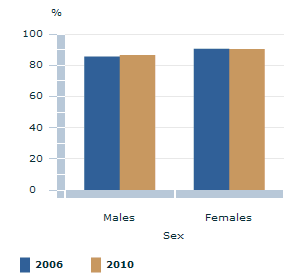
Footnote:
(a) Persons aged 18 years and over.
Source:
ABS General Social Survey: Summary Results, Australia, 2006 & 2010 (cat. no. 4159.0) |
 |  |  |
 |  |  |
 |  |  |
...by age |  |  |
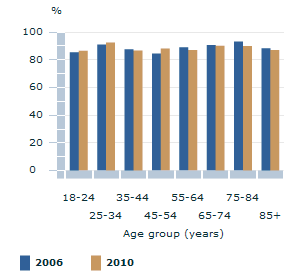
Footnote:
(a) Persons aged 18 years and over.
Source:
ABS General Social Survey: Summary Results, Australia, 2006 & 2010 (cat. no. 4159.0) |  |  |
 |  | |
 |  |  |
 |  |  |
|
| POSITIVE RELATIONSHIPS |
 |
People that feel able to have a say with family or friends on important issues all or most of the time(a) |
 |  |  |
 |  |  |
Progress indicator |  | ...by sex |
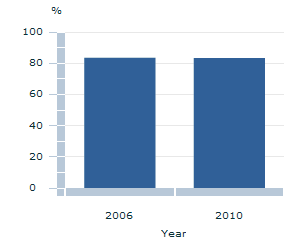
Footnote:
(a) Persons aged 18 years and over.
Source:
ABS General Social Survey: Summary Results, Australia (cat. no. 4159.0) |  | 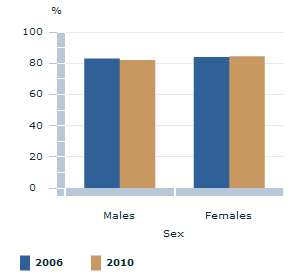
Footnote:
(a) Persons aged 18 years and over.
Source:
ABS General Social Survey: Summary Results, Australia (cat. no. 4159.0) |
 |  |  |
 |  |  |
 |  |  |
...by age |  |  |
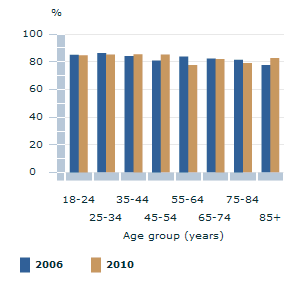
Footnote:
(a) Persons aged 18 years and over.
Source:
ABS General Social Survey: Summary Results, Australia (cat. no. 4159.0) |  |  |
 |  | |
 |  |  |
 |  |  |
|
| CARING RELATIONSHIPS |
 |
People that have a source of support in a time of crisis from persons outside the household(a) |
 |  |  |
 |  |  |
Progress indicator |  | ...by sex |
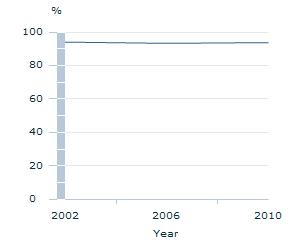
Footnote:
(a) Persons aged 18 years and over.
Source:
ABS General Social Survey: Summary Results, Australia (cat. no. 4159.0) |  | 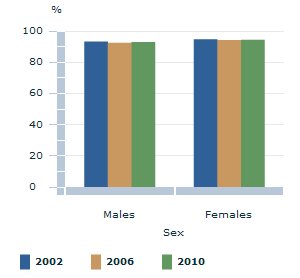
Footnote:
(a) Persons aged 18 years and over.
Source:
ABS General Social Survey: Summary Results, Australia (cat. no. 4159.0) |
 |  |  |
 |  |  |
 |  |  |
...by age |  |  |

Footnote:
(a) Persons aged 18 years and over.
Source:
ABS General Social Survey: Summary Results, Australia (cat. no. 4159.0) |  |  |
 |  | |
 |  |  |
 |  |  |
|
| THRIVING CHILDREN |
 |  |  |
Children who are developmentally vulnerable because of their physical health & wellbeing |
 |  |  |
 |  |  |
Progress indicator |  |  |

Source:
Australian Early Development Index, A Snapshot of Early Childhood Development in Australia, 2012 |  |  |
 |  | |
 |  |  |
 |  |  |
|
| TIME AND SUPPORT |
 |  |  |
People who feel rushed or pressed for time often or always(a) |
 |  |  |
 |  |  |
Progress indicator |  | ...sex |

Footnote:
(a) Persons aged 15 years and over.
Source:
ABS data available on request, 1997 Time Use Survey
ABS How Australians Use Their Time, 2006 (cat. no. 4153.0) |  | 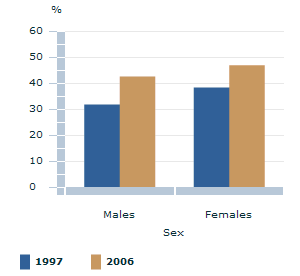
Footnote:
(a) Persons aged 15 years and over.
Source:
ABS data available on request, 1997 Time Use Survey
ABS How Australians Use Their Time, 2006 (cat. no. 4153.0) |
 |  |  |
 |  |  |
 |  |  |
...age |  | ...state and territory |
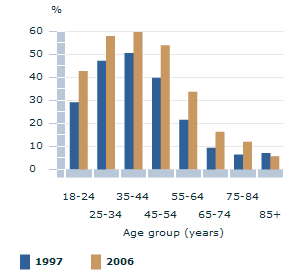
Footnote:
^ Estimate for 75-84 year age group in 2006 has a relative standard error of 10% to less than 25% and should be used with caution.
* Estimates for the 85 years and over age group has a relative standard error of 25% to 50% and should be used with caution.
(a) Persons aged 15 years and over.
Source:
ABS data available on request, 1997 Time Use Survey
ABS How Australians Use Their Time, 2006 (cat. no. 4153.0) |  | 
Footnote:
^ Estimate for Tas. in 2006 has a relative standard error of 10% to less than 25% and should be used with caution.
* Estimates for NT and ACT in 2006 have relative standard errors of 25% to 50% and should be used with caution.
(a) Persons aged 15 years and over.
Source:
ABS data available on request, 1997 Time Use Survey
ABS How Australians Use Their Time, 2006 (cat. no. 4153.0) |
 |  | |
 |  |  |
 |  |  |
|
|
|
|